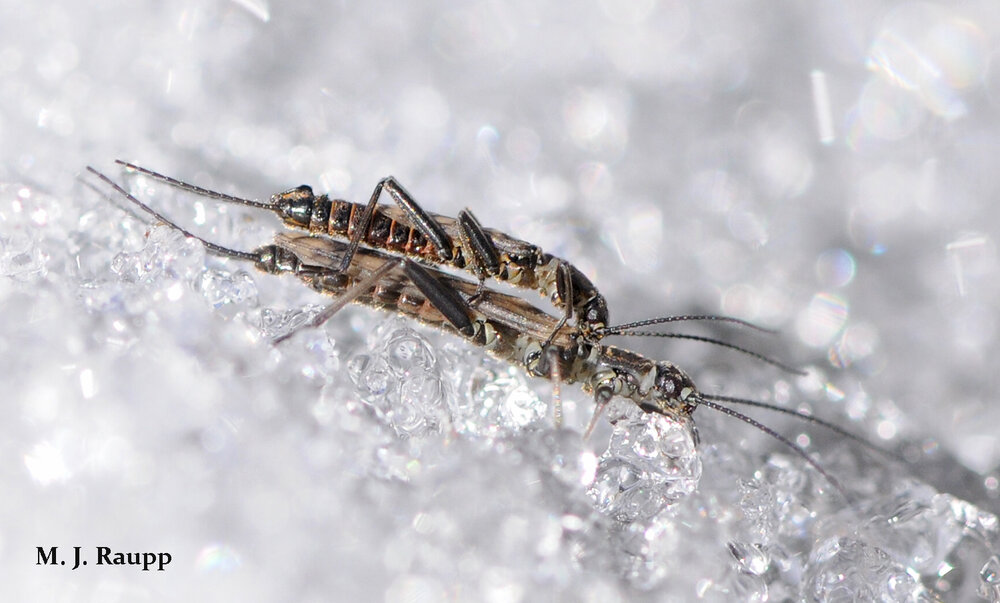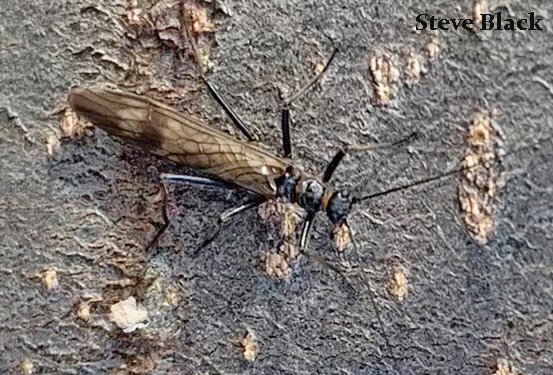Chilly romance for winter stoneflies – Plecoptera: Capniidae and Taeniopterygidae

Snow and ice don’t cool romance for amorous winter stoneflies.

While most insects are scarce and inactive during winter months, winter stoneflies romp about riverbanks and nearby environs even in the dead of winter. Photo credit: Steve Black
This week we turn to the Bug of the Week mailbag where we received a picture of an unusual winter-active insect found on the trunk of a tree. Let’s visit stoneflies, curious amphibious insects whose lives are split between two worlds; a life aquatic in their youth and romantic interludes on land as adults. While many insects migrate or enter a hibernal torpor called diapause during this frosty season, winter stoneflies are in their glory. Special compounds including glycerol, proteins, and sugars act like antifreeze and prevent stoneflies from freezing to death as they cavort on snow covered stream banks. These ancient insects can be found on stones, vegetation, and bridges near small, fast-moving streams. These week’s star was sighted in a nursery near a major river in western Maryland loitering on the bark of a tree.
Adult winter stoneflies are dark brown or black and are active day and night. In their youth, stoneflies live in fresh water, rushing streams and rivers. Juvenile winter stoneflies, called nymphs, graze on submerged aquatic vegetation or decaying organic matter. Other species have abandoned a vegan diet and eat aquatic insects, including other stoneflies. Stonefly nymphs obtain oxygen from the water through delicate gills lining the neck, thorax, or abdomen. Most immature insects shed their skin or molt just a few times as they develop. However, some species of stoneflies may molt more than 20 times before leaving the water as adults in search of mates. The remarkable transformation from nymph to adult transpires at the edge of the stream as the nymph emerges from the water and latches onto a stone, log, or plant. The exoskeleton splits along the midline and the adult stonefly emerges like a wraith from the cast skin. When the exoskeleton hardens, adults walk and fly to find mates. As adults, food choice differs on a species basis. Some eat lichens, algae, or vegetation, but others gain all necessary nutrients as nymphs and never feed as adults. Winter stoneflies are relatively weak fliers and seem to prefer walking and running to flying. However, other species of stoneflies are good fliers and are attracted to porch lights and, unfortunately, bug zappers.
Stonefly courtship is a curious matter. A hopeful guy stonefly strikes the surface of a resting place, such as a small branch or a stone, with its abdomen to create a specific drum beat. If a female of the same species is nearby and favorably impressed by his rhythm and sound, she will drum a reply with her abdomen. The percussive duet continues and if both like what they sense, the deal is sealed and they mate. After mating, the female stonefly will swoop to the surface of the water to deposit her eggs. This is a season of joy for fish living in stonefly laden streams. Trout, steelhead, and other freshwater fish find stonefly nymphs and adults delectable. Both adult and juvenile stoneflies are an important source of food for denizens of our streams. Fisherman have taken advantage of this passion and created a variety of lures that mimic stoneflies with colorful names like Montana Stone Yellow and Henry’s Fork Yellow Sally.
Plucked from a riverbed, a stonefly nymph dashes to return to its watery realm. Shed skins of stoneflies cling to logs and stones near riverbanks where nymphs molt and become adults. On wintry days, males roam icy landscapes and even slowly moving humans in search of mates. Male stoneflies drum their abdomen on substrates including small branches and stones along the river to attract a mate. While inaudible to the human ear, a receptive female will catch his vibe and signal her willingness to mate by returning his percussive performance with one of her own. Who says drummers aren’t romantic?

Clean, fast-moving streams and rivers are excellent places to hunt winter stoneflies.
Stoneflies are also important indicators of water quality. Streams with heavy sediments, low oxygen content, or pollutants do not support a diversity or abundance of stoneflies. Stoneflies emerging from your local stream are a positive sign of a healthy environment. So, during the next couple of weeks, take a walk on a sunny afternoon and visit a small stream or river to seek the stonefly. The best viewing is when stream banks are covered with snow and stoneflies clamber from the chilly waters below. The winter stoneflies featured in this Bug of the Week were observed on warmish afternoons on a small footbridge spanning the Little Patuxent River in Columbia, Maryland, on the Billy Goat Trail along the mighty Potomac River in Maryland, near the Monocacy River in Frederick County, Maryland, and along the banks of Pidcock Creek near Lambertville, Pennsylvania.
References
Bug of the Week thanks Steve Black for sharing his great image of a winter stonefly discovered on a tree-trunk. The fascinating book “Aquatic Entomology” by W. Patrick McCafferty was used as a reference for this Bug of the Week. Here is a link to a really nice article detailing the stonefly’s clever strategies for surviving winter: https://blogs.scientificamerican.com/guest-blog/winter-stoneflies-sure-are-supercool/
This post appeared first on Bug of the Week